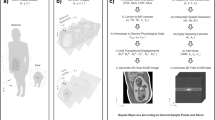Abstract
Purpose
Numerical simulations studying the interactions between radiations and biological tissues require the use of three-dimensional models of the human anatomy at various ages and in various positions. Several detailed and flexible models exist for adults and children and have been extensively used for dosimetry. On the other hand, progress of simulation studies focusing on pregnant women and the fetus have been limited by the fact that only a small number of models exist with rather coarse anatomical details and a poor representation of the anatomical variability of the fetus shape and its position over the entire gestation.
Methods
In this paper, we propose a new computational framework to generate 3D hybrid models of pregnant women, composed of fetus shapes segmented from medical images and a generic maternal body envelope representing a synthetic woman scaled to the dimension of the uterus. The computational framework includes the following tasks: image segmentation, contour regularization, mesh-based surface reconstruction, and model integration.
Results
A series of models was created to represent pregnant women at different gestational stages and with the fetus in different positions, all including detailed tissues of the fetus and the utero-fetal unit, which play an important role in dosimetry. These models were anatomically validated by clinical obstetricians and radiologists who verified the accuracy and representativeness of the anatomical details, and the positioning of the fetus inside the maternal body.
Conclusion
The computational framework enables the creation of detailed, realistic, and representative fetus models from medical images, directly exploitable for dosimetry simulations.
Similar content being viewed by others
References
Dokládal P, Bloch I, Couprie M, Ruijters D, Urtasun R, Garnero L (2003) Topologically controlled segmentation of 3D magnetic resonance images of the head by using morphological operators. Pattern Recognit 36(10): 2463–2478
Burguet J, Bloch I (2004) Homotopic labeling of elements in a tetrahedral mesh for the head modeling. In: Progress in pattern recognition, image analysis and applications, LNCS, vol 3287. Puebla, Mexico, pp 566–573
Burguet J, Gadi N, Bloch I (2004) Realistic models of children heads from 3D MRI segmentation and tetrahedral mesh construction. In: 2nd International symposium on 3D data processing, visualization and transmission, 3DPTV. Thessaloniki, Greece, pp 631–638
Wiart J, Hadjem A, Wong MF, Bloch I (2008) Analysis of RF exposure in the head tissues of children and adults. Phys Med Biol 53: 3681–3695
Stabin MG et al (1995) Mathematical models and specific absorbed fractions of photon energy in the nonpregnant adult females and at the end of each trimester of pregnancy. Oak Ridge National Laboratory; National Technical Information Service, Springfield
Caon M (2004) Voxel-based computational models of real human anatomy: a review. Radiat Environ Biophys 42(4): 229–235
Shi C, Xu XG (2004) Development of a 30-week-pregnant female tomographic model from computed tomography (CT) images for Monte Carlo organ dose calculations. Med Phys 31: 2491–2497
Angel E et al (2008) Radiation dose to the fetus for pregnant patient undergoing multidetector CT imaging: Monte Carlo simulations estimating fetal dose for a range of gestational age and patient size. Radiology 249(1): 220–227
Cech R, Leitgeb N, Pediaditis M (2007) Fetal exposure to low frequency electric and magnetic fields. Phys Med Biol 52(4): 879–888
Chen J (2004) Mathematical models of the embryo and fetus for use in radiological protection. Health Phys 86(3): 285–295
Dimbylow P (2006) Development of pregnant female, hybrid voxel-mathematical models and their application to the dosimetry of applied magnetic and electric fields at 50 Hz. Phys Med Biol 51(10): 2383–2394
Wu D, Shamsi S, Chen J, Kainz W (2006) Evaluations of specific absorption rate and temperature increase within pregnant female models in magnetic resonance imaging birdcage coils. IEEE Trans Microw Theory Techn 54(12): 4472–4478
Xu XG, Chao TC, Bozkurt A (2000) VIP-MAN: an image-based whole-body adult male model constructed from color photographs of the visible man project for multi-particle Monte Carlo calculations. Health Phys 78(5): 476–486
Xu XG, Taranenko V, Zhang J, Shi C (2007) A boundary-representation method for designing whole body radiation dosimetry models: pregnant females at the ends of three gestational periods–RPI-P3, -P6 and -P9. Phys Med Biol 52(23): 7023–7044
Nagaoka T, Togashi T, Saito K, Takahashi M, Ito K, Watanabe S (2007) An anatomically realistic whole-body pregnant-woman model and specific absorption rates for pregnant-woman exposure to electromagnetic plane waves from 10 MHz to 2 GHz. Phys Med Biol 52(22): 6731–6743
Anquez J, Angelini E, Bloch I, Merzoug V, Bellaiche-Millischer AE, Adamsbaum C (2007) Interest of the steady state free precession (SSFP) sequence for 3D modeling of the whole fetus. In: International conference of the IEEE engineering in medicine and biology society. Lyon, France, pp 771–774
Anquez J, Angelini E, Bloch I (2008) Segmentation of fetal 3D ultrasound images based on statistical prior and deformable model. In: IEEE international symposium on biomedical imaging (ISBI). Paris, France, pp 17–20
Anquez J, Angelini E, Bloch I (2009) Automatic segmentation of head structures on fetal MRI. In: IEEE international symposium on biomedical imaging (ISBI). Boston, USA
Anquez J, Boubekeur T, Bibin L, Angelini E, Bloch I (2009) Utero-fetal unit and pregnant woman modeling using a computer graphics approach for dosimetry studies. In: Medical image computing and computerized assisted intervertion, London, UK
Moore KL, Persaud TVN (1993) The developing human: clinically oriented embryology. WB Saunders Company, Philadelphia
Bibin L, Anquez J, Hadjem A, Angelini E, Wiart J, Bloch I (2009) Dosimetry studies on a fetus model combining medical image information and synthetic woman body. In: 11th World congress on medical physics and biomedical engineering. Munich, Germany
Author information
Authors and Affiliations
Corresponding author
Rights and permissions
About this article
Cite this article
Bibin, L., Anquez, J., Angelini, E. et al. Hybrid 3D pregnant woman and fetus modeling from medical imaging for dosimetry studies. Int J CARS 5, 49–56 (2010). https://doi.org/10.1007/s11548-009-0381-3
Received:
Accepted:
Published:
Issue Date:
DOI: https://doi.org/10.1007/s11548-009-0381-3




